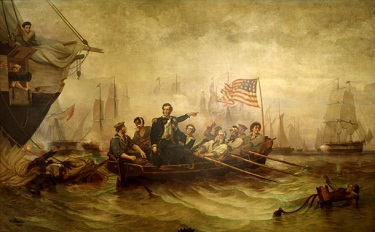When the United States declared war on June 18, 1812, there was some hope among Republican leaders that the news would bring the British to their senses and that they would cave in to American demands. The nation’s war aims might thus be won without any fighting. If combat operations were necessary, the fledgling republic could hardly hope to defeat the British on the high seas. The only alternative was to strike at Britain’s North American provinces in Canada and hope to use territory conquered
“no expense of blood, or treasure, on our part—Canada is to conquer herself—she is to be subdued by the principles of fraternity.” John Randolph

Painter William H. Powell, US Senate
The conquest of most of Canada was expected to be, in the words of Thomas Jefferson, “a mere matter of marching.” The United States had a huge population advantage—7.7 million to 500,000—and many people living north of the border—the original French population and recent American immigrants who had moved to Canada to take advantage of free land and low taxes—were not expected to put up much of a fight. Many Republicans anticipated what antiwar critic John Randolph of Virginia called “a holiday campaign.” With “no expense of blood, or treasure, on our part—Canada is to conquer herself—she is to be subdued by the principles of fraternity.”
Few Americans anticipated how difficult a Canadian campaign might be. Although the bulk of the British army was tied up in the Spanish Peninsula, the small force charged with protecting Canada was ably led and combat tested and was aided in no small manner by Britain’s Indian allies. These included various tribes in the Old Northwest led by two Shawnee brothers, Tecumseh and the Prophet, and the Grand River Iroquois (Haudenosaunee) in Upper Canada (now Ontario) under the leadership of a Scottish-Cherokee mixed-blood, John Norton, whose native name was Teyoninhokovrawen but who was popularly known as “the Snipe.” Americans also underestimated the stupendous logistical problems of waging war in a distant wilderness, the profound lack of readiness of an American army filled with amateur officers and untried enlisted men, and the lack of dependability of a militia that had little discipline or training and even less taste for battle, especially outside the United States.
The young republic was unable to overcome these obstacles, and the invasions of 1812 and 1813 ended in failure. The only bright spots were in the West. In the Old Northwest, Master Commandant Oliver H. Perry’s victory on Lake Erie in 1813 paved the way for Major General William Henry Harrison’s victory in the Battle of the Thames. Harrison’s victory established American dominance in the region, shattered the Indian confederacy, and led to Tecumseh’s death. Major General Andrew Jackson secured a similar dominion over the Old Southwest with a series of victories over the Creeks. The western victories were undoubtedly significant because they paved the way for American expansion, but they were too far from the centers of power further east to alter the course of the war with Great Britain.
There were several spectacular American naval victories on the high seas, most notably by the US frigate Constitution, but these were in single-ship duels of little strategic consequence. American warships and privateers also took a heavy toll on British commerce. Great Britain found these losses annoying but hardly a reason to make peace. The British responded to the affronts at sea by imposing an even more extensive blockade on the American coast, which undermined American prosperity and cut sharply into government revenue. Although Americans might be justly proud of their showing in the West and at sea, after two years of campaigning, the war was essentially a stalemate. Canada remained in British hands, and the United States was no closer to victory.
Part of a series of articles titled The Global Context of the War of 1812 .
Last updated: March 10, 2015
